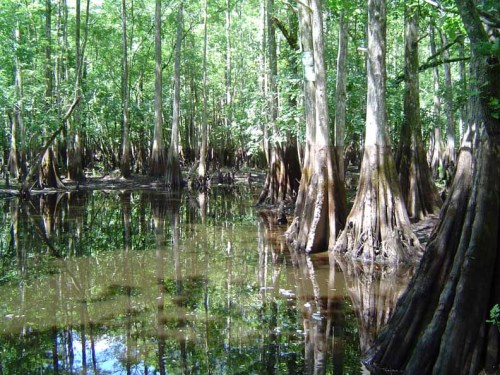I know – the time between my blogs is way too long and inexcusable. I can expect to build up a consistent following when I don’t post very often! My only excuse is that my blog is informational and educational not a commentary on what is happening in my life. So I apologize to the following that I have that it has been so long again!
This blog is a continuation of the topic of mitigation. In my last blog I discussed options for mitigating for wetland impacts. For this one I will outline the types of compensation commonly used to offset impacts to threatened and endangered wildlife species. My November 2009 blog discussed threatened and endangered species and outlined the types of activities that typically constitute impacts.
Threatened and Endangered Species and Mitigation
The trick with protected species is to avoid “taking” them.
The determination of whether an impact has occurred to protected species is relatively more straightforward than that for wetlands – if you take down a tree containing a bald eagle nest you have impacted that eagle or if you bulldoze over the top of a gopher tortoise burrow you have impacted that tortoise. If a site development proposes activities that may “incidentally” impact threatened and endangered species as a result of otherwise lawful activities permits allowing those impacts may be issued by regulatory agencies. If permits are issued they typically come with the provision that compensation must be completed to offset those impacts.
Compensation Alternatives
In general there are three techniques that can be used to mitigate for impacts to protected species. They are: On-site preservation/buffers, Off-site purchase of land, and relocation.
On-site preservation/buffers: On-site Preservation is mostly used for species that are sedentary and that need large tracts of very specific types of plant communities such as Florida Scrub Jays. If there are scrub jays on a property, it might be necessary to set aside the entire portion of the property that is inhabited by scrub jays that is then maintained in its natural state and periodically managed to make sure that the conditions stay suitable for that species.

An on-site buffer might be used if you have a species that can be particularly sensitive to human disturbance such as bald eagles. For example if there is a bald eagle nest on the property, buffers restricting development of up to 1500 feet from the nest could be required.
Often on-site preservation is a component of buffers (as with the land in the 1500 foot buffer around a bald eagle nest) but buffers can be required beyond the boundaries of actual inhabited boundaries, such as with a gopher tortoise.
Off-site purchase of land: This method would include the purchase of land away from the development site that either already provides habitat and resident protected species similar to that on the development site or that could be enhanced or restored through management to create suitable habitat for species that are proposed for impact.
Relocation: This is the removal of a species from the development tract and transporting it to an appropriate recipient site away from the development. This can include a portion of the property that is not slated for development or land off-site that has been set aside as a conservation area. Most people are familiar with the concept of relocating gopher tortoises off a property being developed. This currently is the mitigation method being pushed by the state. A number of approved relocation tracts have been established and the tortoises are excavated from their burrows and transported to one of these recipient sites. An example of the cost for that could be $800 to $1000/tortoise to the owner of the recipient site and another $300 to the state to be used for land management in addition to the cost of the permit itself.

Real Estate and Threatened and Endangered Species
As with wetlands, there is no size limit on a property that can be occupied by protected species and; therefore, be subject to permitting and possibly the need to complete mitigation.
How much actual land is buildable (not inhabited by protected species), whether you can obtain a permit to impact occupied habitat to open up more land for development, and the cost of mitigation may all contribute to the value that can be put on the land if you are a Seller. Just like with wetlands, the Seller has the choice of addressing some or all of these issues prior to the sale of the property or of leaving it up to the buyer to deal with. If the Seller does some of the work sometimes they can recoup at least a portion of the money laid out for those activities within the sales price.
Remember “Buyer Beware”? That applies here again. Buyers need to be sure to build plenty of due diligence time into the contract for purchase so that they can determine if the site is occupied by any threatened or endangered species and to coordinate with regulatory agencies to determine if developing the property is even feasible and; consequently, what mitigation might be required.
Knowing that additional monies will have to be laid out for complex permitting and mitigation may allow a buyer to negotiate a better price for the property, leaving them with the funds to complete the development even with the protected species permitting challenges and costs that they may face. So let’s say you are thinking of buying a piece of property that is occupied by gopher tortoises, you will need to know how much the property is listed for but also how much money might have to be budgeted for environmental studies, permitting, and mitigation such as relocation – all before any other construction costs are considered. The price offer to the seller might deduct some or all of these projected costs from the asking price of the property.
So as with my other blogs, my advice is hire an environmental consultant to make sure you are aware of environmental issues that you will be dealing with regardless if you are the Seller or the Buyer. Remember KNOWLEDGE IS POWER!
 Normally, we would consider that the removal (or delisting) of a wildlife species, such as the
Normally, we would consider that the removal (or delisting) of a wildlife species, such as the 
![wetlands_bulldozer[1] wetlands_bulldozer[1]](https://envirodiva.files.wordpress.com/2009/09/wetlands_bulldozer1.jpg?w=500)


